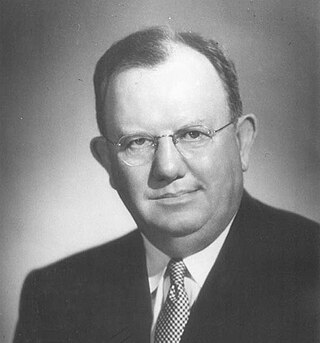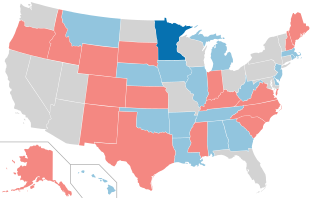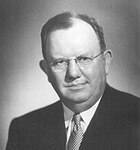
Homer Earl Capehart was an American businessman and politician from Indiana. After serving in the United States Army during World War I, he became involved in the manufacture of record players and other products. Capehart later served 18 years (1945–1963) in the U.S. Senate as a Republican from Indiana. Initially an isolationist on foreign policy, he took a more internationalist stance in later years; he retired after a narrow defeat for a fourth term in 1962.

William Ezra Jenner was an American lawyer and politician from the state of Indiana. A Republican, Jenner was an Indiana state senator from 1934 to 1942, and a U.S. senator from 1944 to 1945 and again from 1947 to 1959. In the Senate, Jenner was a supporter of McCarthyism.

These are tables of congressional delegations from Indiana to the United States House of Representatives and the United States Senate.

The 1990 United States Senate elections were held on Tuesday, November 6, 1990, with the 33 seats of Class 2 contested in regular elections. Special elections were also held to fill vacancies. The Democratic Party increased its majority with a net gain of one seat from the Republican Party. The election took place in the middle of President George H. W. Bush's term, and, as with most other midterm elections, the party not holding the presidency gained seats in Congress.

The 1982 United States Senate elections were held on November 2, 1982. They were elections for the United States Senate following Republican gains in 1980. The 33 Senate seats of Class 1 were up for election in 1982. A total of four seats changed hands between parties, with Democrats winning seats in New Jersey and New Mexico, and Republicans taking seats in Nevada and the seat of the lone independent, Senator Harry Byrd Jr., in Virginia. Democrats made a net gain of one seat in the elections, while Republicans stayed at 54 seats for a majority. However, the Democratic gain in New Jersey replaced a Republican that had been appointed earlier in the year.

The 1958 United States Senate elections were elections for the United States Senate which occurred in the middle of President Dwight D. Eisenhower's second term. Thirty-two seats of Class 1 were contested in regular elections, the new state of Alaska held its first Senate elections for its Class 2 and 3 seats, and two special elections were held to fill vacancies.

The 1950 United States Senate elections occurred in the middle of Harry S. Truman's second term as president. The 32 seats of Class 3 were contested in regular elections, and four special elections were held to fill vacancies. As with most 20th-century second-term midterms, the party not holding the presidency made significant gains. The Republican opposition made a net gain of five seats, taking advantage of the Democratic administration's declining popularity during the Cold War and the aftermath of the Recession of 1949. The Democrats held a narrow 49-to-47-seat majority after the election. This was the first time since 1932 that the Senate majority leader lost his seat, and the only instance of the majority leader losing his seat while his party retained the majority.

The 1944 United States Senate elections coincided with the re-election of Franklin D. Roosevelt to his fourth term as president. The 32 seats of Class 3 were contested in regular elections, and three special elections were held to fill vacancies.

Henry Frederick Schricker was an American politician who served as the 36th and 38th Governor of the U.S. state of Indiana from 1941 to 1945 and from 1949 to 1953. He is the only Indiana governor elected to two non-consecutive terms, and the only governor between 1852 and 1977 to be elected to more than one term in office. His terms were marked by strong opposition party control of the Indiana General Assembly, which attempted to remove powers from the governor that had been granted during the Great Depression. Schricker fought the attempt in the state courts, and although his power was significantly reduced, the Indiana Supreme Court ruled in the case of Tucker v. Indiana that the governor was the chief executive of the state, and the legislature could not pass legislation that interfered with the division of powers.

Frederick Van Nuys was a United States senator from Indiana. Born in Falmouth, he attended the public schools and graduated from Earlham College in 1898 and from Indiana Law School in 1900. He was admitted to the bar in 1900 and commenced practice in Shelbyville moving shortly afterward to Anderson. From 1906 to 1910 he was prosecuting attorney of Madison County and was a member of the Indiana Senate from 1913 to 1916, serving as president pro tempore in 1915. He moved to Indianapolis in 1916 and continued the practice of law; he was United States Attorney for the U.S. District of Indiana from 1920 to 1922.

The 1944 United States Senate special election in Massachusetts was held on November 7, 1944. Republican Governor Leverett Saltonstall was elected to finish the term of Henry Cabot Lodge, Jr., who had resigned from the Senate to serve in World War II.

The 1932 United States Senate election in Indiana took place on November 8, 1932. Incumbent Republican Senator and Senate Majority Leader James E. Watson ran for a third term in office, but was defeated by Frederick Van Nuys in a landslide.

The 1938 United States Senate election in Indiana took place on November 8, 1938. Incumbent Democratic Senator Frederick Van Nuys was narrowly re-elected to a second term in office over Raymond E. Willis by a margin of 5,197 votes out of over 1.5 million cast.

The 1952 United States Senate election in Indiana took place on November 4, 1952. Incumbent Republican U.S. Senator William E. Jenner was for re-elected to a second term in office over Governor of Indiana Henry F. Schricker.

The 1956 United States Senate election in Indiana took place on November 6, 1956. Incumbent Republican U.S. Senator Homer Capehart was re-elected to a third term in office, defeating former U.S. Secretary of Agriculture Claude Wickard.

The 1950 United States Senate election in Indiana took place on November 7, 1950. Incumbent Republican U.S. Senator Homer Capehart was re-elected to a second term in office, defeating Democrat Alex Campbell.

The 1944 United States Senate election in Iowa took place on November 7, 1944. Incumbent Democratic Senator Guy M. Gillette ran for a second full term in office but was defeated by Republican Governor Bourke B. Hickenlooper.

The 1926 United States Senate election in Indiana took place on November 2, 1926. Incumbent Republican Senator James E. Watson was re-elected to a second full term in office over Democratic attorney Albert Stump.

The 1928 United States Senate election in Indiana took place on November 6, 1928. Incumbent Republican U.S. Senator Arthur Robinson, who had been appointed and elected to finish the unexpired term of Samuel Ralston, was re-elected to a full term in office.

The 1962 United States Senate election in Indiana took place on November 6, 1962. Incumbent Republican U.S. Senator Homer Capehart ran for re-election to a fourth consecutive term in office, but was narrowly defeated by Democratic State Representative Birch Bayh.


















